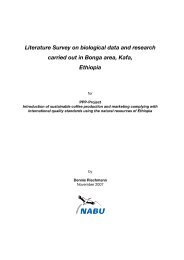Flora Biodiversity Assessment in Bonga, Boginda and Mankira Forest
Flora Biodiversity Assessment in Bonga, Boginda and Mankira Forest
Flora Biodiversity Assessment in Bonga, Boginda and Mankira Forest
Create successful ePaper yourself
Turn your PDF publications into a flip-book with our unique Google optimized e-Paper software.
3.3.5 Comparison of <strong>Forest</strong> areas (<strong>Bonga</strong>, Bog<strong>in</strong>da <strong>and</strong> <strong>Mankira</strong>) with<br />
respect to density of flora<br />
a. <strong>Forest</strong><br />
All flora recorded (grass, herb, regeneration, sapl<strong>in</strong>gs of woody plant, shrubs, <strong>and</strong> trees)<br />
per ha are comb<strong>in</strong>ed <strong>and</strong> their density per ha is presented <strong>in</strong> the Table below (Table 5 &<br />
figure 16 consecutively). Accord<strong>in</strong>gly <strong>Bonga</strong> forest 1 has the largest plant cover per ha<br />
(estimated to be more than1,309,956). <strong>Mankira</strong> <strong>and</strong> Bog<strong>in</strong>da have lower number of floral<br />
density, each compris<strong>in</strong>g 510,120 <strong>and</strong> 386,600, respectively. The reason for such big<br />
variation could be that average slope <strong>in</strong>cl<strong>in</strong>ation of sample plots <strong>in</strong> <strong>Bonga</strong> forest fell <strong>in</strong><br />
slopes less than 30 percent. Bog<strong>in</strong>da has the steepest gradient <strong>and</strong> average slope of all<br />
sample plots is estimated as 53 percent. <strong>Mankira</strong> on the other h<strong>and</strong> has 36 percent<br />
average gradient of sample plots.<br />
When an area is steep, undergrowth condition might not be as flourish<strong>in</strong>g as gentle slope<br />
or flat area because soil might be washed to gorges <strong>and</strong> downslopes dur<strong>in</strong>g ra<strong>in</strong>y season.<br />
Other factor could be that most of the areas are occupied by forest coffee either<br />
<strong>in</strong>tensively or extensively managed or not managed at all. Presence of management of<br />
coffee <strong>in</strong>fluences undergrowth condition as most of the undergrowth is cleared to reduce<br />
competition <strong>and</strong> allow access to human movement.<br />
Table 5. Density of plants per stratum<br />
<strong>Forest</strong> area<br />
Number of plants per<br />
hectare<br />
<strong>Bonga</strong> 1309956<br />
Bog<strong>in</strong>da 386600<br />
<strong>Mankira</strong> 510120<br />
Source: <strong>Flora</strong> <strong>Biodiversity</strong> <strong>Assessment</strong>, 2008<br />
1 See annex I for def<strong>in</strong>itions of forest, shrubs <strong>and</strong> tree<br />
36



